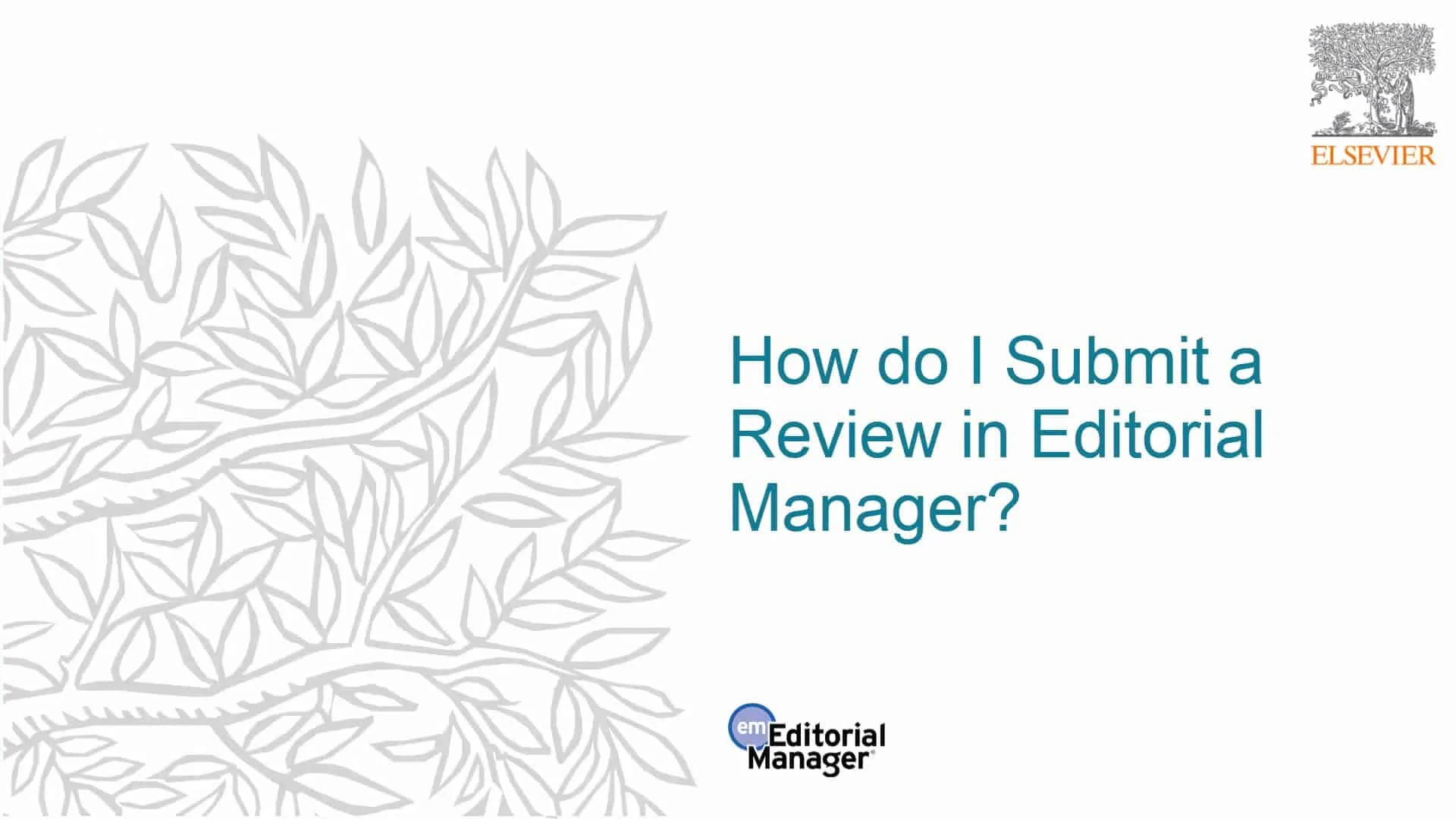How to conduct a review
1. Before you begin
Before you accept or decline an invitation to review, consider the following questions:
Does the article match your area of expertise? Only accept if you feel you can provide a high-quality review.
Do you have a potential conflict of interest abre em uma nova guia/janela? Disclose this to the editor when you respond.
Do you have time? Reviewing can be a lot of work — before you commit, make sure you can meet the deadline.
Do you need to find out more about reviewing and the peer review process? If so, check out the free tutorials on the Elsevier Researcher Academy abre em uma nova guia/janela, especially the Certified Peer Reviewer course abre em uma nova guia/janela.
Respond to the invitation as soon as you can (even if it is to decline) — a delay in your decision slows down the review process and means more waiting for the author. If you do decline the invitation, it would be helpful if you could provide suggestions for alternative reviewers.
2. Managing your review
Confidential material
If you accept, you must treat the materials you receive as confidential documents. This means you can’t share them with anyone without prior authorization from the editor. Since peer review is confidential, you also must not share information about the review with anyone without permission from the editors and authors.
Generative AI
Reviewing a scientific paper implies responsibilities that can only be attributed to humans. The critical thinking and assessment required for peer-review are outside the scope of generative AI and AI-assisted technologies, and there is a risk that the technology will generate incorrect, incomplete or biased conclusions. These considerations, together with the principle that submitted manuscripts are to be treated as confidential documents, underpins our Generative AI policies for reviewers and editors:
Reviewers or editors should not upload the manuscript or any part of it into a Generative AI tool, as there is no guarantee of where materials are being sent, saved, or viewed, or how they may be used in the future and this may violate the authors’ confidentiality, proprietary and/or data privacy rights. It may also violate the terms of use of the Generative AI tool.
This confidentiality requirement extends to the peer review report and any other communication about the manuscript, such as the notification or decision letters, as they may also contain confidential information about the manuscript and/or the authors. For this reason, they should not be uploaded into a Generative AI tool, even if it is just for the purpose of improving language and readability.
Generative AI should not be used to assist in the review, evaluation or decision-making process of a manuscript.
Elsevier embraces new AI-driven technologies that support reviewers and editors in the editorial process, such as those used during the screening process to conduct completeness and plagiarism checks and identify suitable reviewers. These identity-protected technologies conform to the RELX Responsible AI Principles abre em uma nova guia/janela. We continue to develop and adopt in-house or licensed technologies that can assist editors and reviewers while respecting confidentiality, proprietary and data privacy rights.
How to log in and access your review
Your review will be managed via an Elsevier submission system such as Editorial Manager abre em uma nova guia/janela. Elsevier journals use different submission systems so there is no one generic login link. To access the paper and deliver your review, click on the link in the invitation email you received which will bring you to the submission/reviewing system.
How to submit a review in Editorial Manager

Watch now
|
How to submit a review in Editorial Manager
Article- and journal-specific instructions
When you sit down to write the review, make sure you familiarize yourself with any journal-specific guidelines (these will be noted in the journal’s guide for authors available on each journal’s homepage).
Some of our journals employ “structured peer review” whereby you will receive a series of questions to make it easier for you to convey recommendations for improvement in a structured manner. These questions address different aspects of the manuscript, such as the quality of the data analysis, reproducibility, and the overall clarity of the manuscript. You can find an overview of the core questions (note that journals may also employ additional journal-specific questions).
In any review, please keep the author (instead of the editor) in mind when preparing your replies as your comments will likely be included in the decision letter sent to the author. Also please make sure to reply to the questions in sufficient detail when you are submitting your report in Editorial Manager, to enable the author to most effectively improve the manuscript based on your comments.
If the journal in question does not require you to respond to a list of specific questions, you might find it useful to consider these questions and the below generic points when you are preparing your review report.
Full length research article
Examine the importance of the research question addressed in the manuscript (e.g., are objectives and justification clearly stated?)
Assess the originality (contribution, addition of knowledge to scientific literature or field) of the manuscript
Clearly identify the strengths and weaknesses of the method described in the manuscript
Make specific useful comments on the writing of the manuscript (e.g., writing, organization, figures, etc.)
Offer specific comments on the author’s interpretation of the results and conclusions drawn from the results
In case applicable, comment on the statistics (for example question if they are robust and fit-for-purpose and if the controls and sampling mechanisms are sufficient and well described)
Review article
Discuss the importance of the topic/scope of the review
Assess the originality of the review
Comment on the author's representation of the most relevant recent advances in the field; specifically, determine whether the references are relevant to the topic and cover both historical literature and more recent developments
Offer comments on the writing, organization, tables and figures of the manuscript
Comment on the author's interpretation of the results
In any case, your first task is to read the article. You might consider spot checking major issues by choosing which section to read first. Below we offer some tips about handling specific parts of the paper.
Methodology
If the manuscript you are reviewing is reporting an experiment, check the methods section first. The following cases are considered major flaws and should be flagged:
Unsound methodology
Discredited method
Missing processes known to be influential on the area of reported research
A conclusion drawn in contradiction to the statistical or qualitative evidence reported in the manuscript
For analytical papers examine the sampling report, which is mandated in time-dependent studies. For qualitative research make sure that a systematic data analysis is presented and sufficient descriptive elements with relevant quotes from interviews are listed in addition to the author’s narrative.
For more details and guidance you might find it helpful to view the information on structured peer review.
Sex and gender reporting
Although it might sound late, given that the research has already been concluded and the data analyzed, the peer review process can still play an important role in ensuring effective, transparent and complete sex and gender reporting.
Assess manuscripts for inclusion of sex-disaggregated data and gender analysis. It could well be that the study was not designed to analyze sex and/or gender. Nevertheless, we recommend referees to consider if sex and gender are relevant to the topic of the study, and whether the study follows relevant guidelines, wherever applicable.
As a general principle, the SAGER guidelines abre em uma nova guia/janela recommend careful use of the words “sex” and “gender” in order to avoid confusing both terms. The use of common definitions will improve the ability to conduct meta-analyses of published and archived data. The term “sex” should be used as a classification of male or female based on biological distinction to the extent that this is possible to confirm. Per Heidari et al. abre em uma nova guia/janela: "Gender refers to the socially constructed roles, behaviours and identities of female, male and gender-diverse people . It influences how people perceive themselves and each other, how they behave and interact and the distribution of power and resources in society. Gender is usually incorrectly conceptualized as a binary (female/ male) factor. In reality, there is a spectrum of gender identities and expressions defining how individuals identify themselves and express their gender."
Please check if authors have underlined in the methods section whether the sex of participants was defined based on self-report or assigned following external or internal examination of body characteristics, or through genetic testing or other means. In studies of animals, the term “sex” should be used. In cell biological, molecular biological or biochemical experiments, the origin and sex chromosome constitutions of cells or tissue cultures should be stated. If unknown, the reasons should be stated. In other disciplines, such as the testing of devices or technology, authors should explain whether it will be applied or used by all genders and if it has been tested with a user’s gender in mind. Please check whether the authors have done due diligence and reported any previous studies in the introductions that reveal or refute potential sex or gender differences, and the rationale why they have or have not examined these aspects in their study.
If the study included only one sex/gender, ensure this has been justified. If the study included more than one sex/gender, ensure data are reported for all the options that were recorded and that data disaggregated by sex/gender are reported in full, in the main text or in the appendix or supplementary materials. It is important to assess whether the methodology is appropriate to capture possible sex and gender aspects. As a peer reviewer you may request sub-group analysis if deemed necessary and check if all data are provided disaggregated by sex, as a minimum.
Finally, please also pay attention to whether authors have clearly justified in the discussion section any limitation of their study due to lack of any sex- and gender-based analysis and/or the implications on the generalizability and interpretation of their findings in light of that. It could be that the study was not designed to analyze sex and/or gender, nevertheless, it is important to consider if sex and gender are relevant to the topic of the study, and whether the study follows relevant guidelines, wherever applicable.
Research data and visualizations
Once you are satisfied that the methodology is sufficiently robust, examine any data in the form of figures, tables, or images. Authors may add research data, including data visualizations, to their submission to enable readers to interact and engage more closely with their research after publication. Please be aware that links to data might therefore be present in the submission files. These items should also receive your attention during the peer review process. Manuscripts may also contain database identifiers or accession numbers (e.g., genes) in relation to our database linking program.
Critical issues in research data, which are considered to be major flaws can be related to insufficient data points, statistically non-significant variations and unclear data tables.
NB for certain types of visualization, preview tools are available, allowing you to inspect how files will display on ScienceDirect if the manuscript is accepted. For other data visualizations, there may be other ways of inspecting the files.
Ethical considerations
Experiments including patient or animal data should properly be documented. Most journals require ethical approval by the author’s host organization. Please check journal-specific guidelines for such cases (available from the journal’s homepage, accessible via the journal catalogue.
Overview
If you don’t spot any major flaws, take a break from the manuscript, giving you time to think. Consider the article from your own perspective. When you sit down to write the review, again make sure you familiarize yourself with any journal-specific guidelines (these will be noted in the journal’s guide for authors).
3. Structuring your review
Your review will help the editor decide whether or not to publish the article. It will also aid the author and allow them to improve their manuscript. Giving your overall opinion and general observations of the article is essential. Your comments should be courteous and constructive, and should not include any ad hominem remarks or personal details including your name (unless the journal you are invited to review for employs open peer review).
Providing insight into any deficiencies is important. You should explain and support your judgement so that both editors and authors are able to fully understand the reasoning behind your comments. You should indicate whether your comments are your own opinion or are reflected by the data and evidence.
Checklist
The journal for which you are reviewing might have a specific format (e.g., questionnaire) or other instructions for how to structure your feedback. Below are some general tips on what to include/consider if no other guidelines apply. View the checklist.
Also, here is an example of a published peer review report abre em uma nova guia/janela.
Your recommendation
When you make a recommendation, it is worth considering the categories the editor will likely use for classifying the article:
Reject (explain your reasoning in your report)
Accept without revision
Revise — either major or minor (explain the revision that is required, and indicate to the editor whether you would be happy to review the revised article); if you are recommending a revision, you must furnish the author with a clear, sound explanation of why this is necessary
Bear in mind that there will be the opportunity to direct separate comments to both the editor and author. Once you are ready to submit your report, follow the instructions in the email or visit our support center abre em uma nova guia/janela if you encounter any difficulties.
Access the support center abre em uma nova guia/janela for further help.
The final decision
The editor ultimately decides whether to accept or reject the article. Elsevier plays no part in this decision. The editor will weigh all views and may call for another opinion or ask the author for a revised paper before making a decision. The submission system provides reviewers with a notification of the final decision, if the journal has opted in to this functionality.
4. After your review
Once you have delivered your review, you might want to make use of Elsevier’s Reviewer Hub abre em uma nova guia/janela to ensure that you receive credit for your work. The platform provides a private profile page, certificates, editor recognition as well as discounts for Elsevier services.
Do not forget that, even after finalizing your review, you must treat the article and any linked files or data as confidential documents. This means you must not share them or information about the review with anyone without prior authorization from the editor.
Finally, we take the opportunity to thank you sincerely on behalf of the journal, editors and author(s) for the time you have taken to give your valuable input to the article.




